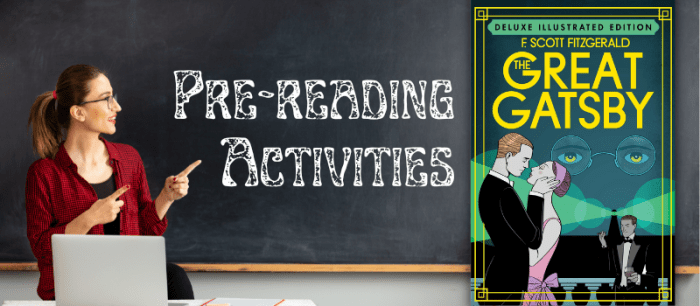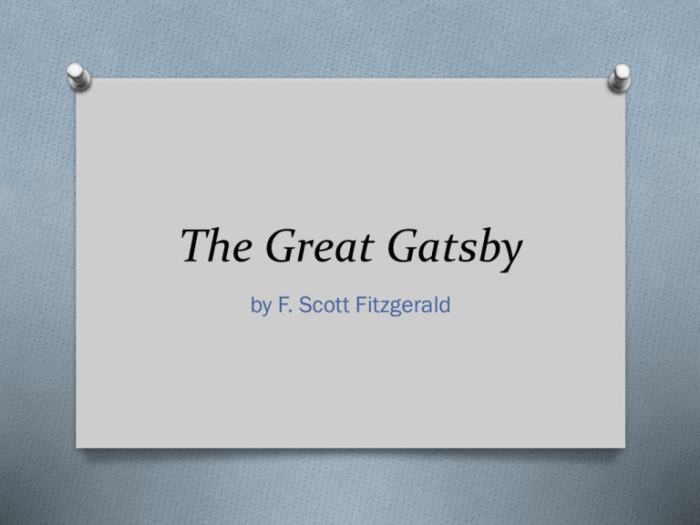The great gatsby pre reading activities – Embark on an enriching pre-reading journey for F. Scott Fitzgerald’s literary masterpiece, The Great Gatsby. This guide delves into the historical and cultural context of the Roaring Twenties, the life and works of F. Scott Fitzgerald, and the intricate tapestry of characters, themes, and literary devices that define this iconic novel.
Through engaging activities and insightful discussions, readers will gain a deeper understanding of the novel’s setting, symbolism, and enduring legacy in American literature.
The Roaring Twenties
The 1920s, known as the Roaring Twenties, was a decade of profound social and cultural change in the United States. The end of World War I marked a shift towards a more modern and progressive era, characterized by economic prosperity, technological advancements, and a loosening of social norms.
The decade witnessed the rise of consumerism, the expansion of the automobile industry, and the emergence of mass entertainment, including radio and cinema. The Jazz Age, a vibrant cultural movement, permeated American society, influencing music, fashion, and lifestyle.
Key events and figures of the Roaring Twenties include the ratification of the 19th Amendment, granting women the right to vote; the rise of organized crime, particularly in major cities like Chicago; and the emergence of the Lost Generation of writers, including F.
Scott Fitzgerald and Ernest Hemingway.
The Impact of the Jazz Age on American Society
- Popularized jazz music and dance, influencing fashion and social behavior.
- Led to the emergence of speakeasies and nightclubs, providing a space for rebellion and escape from Prohibition.
- Challenged traditional values and norms, fostering a more liberal and experimental outlook on life.
F. Scott Fitzgerald

Biographical Information
Francis Scott Key Fitzgerald was born in 1896 in St. Paul, Minnesota. He attended Princeton University but dropped out to join the army during World War I. After the war, he moved to New York City and began his writing career.
Fitzgerald’s early success came with his novel “This Side of Paradise” (1920), which captured the disillusionment and restlessness of the post-war generation. He married Zelda Sayre in 1920, and they became one of the most famous literary couples of the Roaring Twenties.
Writing Style and Literary Themes
Fitzgerald’s writing style is characterized by its lyrical prose, vivid imagery, and exploration of complex emotions. His works often explore themes of the American Dream, love, and loss.
Significance of “The Great Gatsby”
“The Great Gatsby” (1925) is Fitzgerald’s masterpiece and one of the most celebrated American novels of the 20th century. It tells the tragic story of Jay Gatsby, a self-made millionaire who throws lavish parties in an attempt to win back his lost love, Daisy Buchanan.
The novel is a complex exploration of the American Dream and the impossibility of recapturing the past. It is also a poignant portrayal of love, loss, and the human condition.
Characters and Relationships

Main Characters
- Jay Gatsby: A wealthy and mysterious man who throws lavish parties in an attempt to win back Daisy Buchanan.
- Daisy Buchanan: A beautiful and wealthy woman who is married to Tom Buchanan.
- Tom Buchanan: A wealthy and arrogant man who is Daisy’s husband.
- Nick Carraway: The narrator of the novel and a young man who moves to West Egg and becomes Gatsby’s neighbor.
Relationships
- Gatsby and Daisy: Gatsby is deeply in love with Daisy, but their relationship is complicated by her marriage to Tom.
- Tom and Daisy: Tom is a controlling and abusive husband, but Daisy remains loyal to him.
- Nick and Gatsby: Nick is initially drawn to Gatsby’s charisma and wealth, but he eventually comes to understand the tragedy of his life.
Symbolism of the Green Light
The green light at the end of Daisy’s dock symbolizes Gatsby’s hope for the future and his desire to win back Daisy. It is a powerful symbol of Gatsby’s dream and the impossibility of recapturing the past.
Themes and Motifs
Major Themes
- The American Dream: The novel explores the American Dream and the impossibility of achieving it. Gatsby’s pursuit of wealth and success ultimately leads to his downfall.
- Love: The novel explores the different types of love, including romantic love, platonic love, and self-love.
- Loss: The novel is a meditation on loss, both personal and societal. Gatsby loses Daisy, Nick loses Gatsby, and America loses its innocence after World War I.
Symbols and Motifs
- The green light: The green light at the end of Daisy’s dock symbolizes Gatsby’s hope for the future and his desire to win back Daisy.
- The Valley of Ashes: The Valley of Ashes is a desolate wasteland that represents the moral and economic decay of America.
- The eyes of Dr. T.J. Eckleburg: The eyes of Dr. T.J. Eckleburg are a billboard advertisement that overlooks the Valley of Ashes. They are a symbol of God’s judgment and the moral emptiness of American society.
Significance of the Setting
The novel is set in the fictional towns of West Egg and East Egg on Long Island. West Egg represents the new money and the American Dream, while East Egg represents the old money and the established social order.
The contrast between these two worlds highlights the social and economic divisions of American society in the 1920s.
Literary Devices
Foreshadowing
Fitzgerald uses foreshadowing throughout the novel to hint at Gatsby’s tragic end. For example, Nick’s description of Gatsby’s car as a “death car” foreshadows Gatsby’s death in a car accident.
Symbolism
Fitzgerald uses symbolism extensively in the novel. The green light, the Valley of Ashes, and the eyes of Dr. T.J. Eckleburg are all powerful symbols that represent different aspects of American society.
Imagery
Fitzgerald’s use of imagery is vivid and evocative. He creates a rich and detailed world that immerses the reader in the novel’s setting and atmosphere.
Narrative Perspective
The novel is narrated by Nick Carraway, a young man who moves to West Egg and becomes Gatsby’s neighbor. Nick’s perspective is limited, and he can only tell the story from his own point of view.
This narrative perspective creates a sense of mystery and ambiguity, and it allows the reader to interpret the events of the novel in their own way.
Adaptations and Legacy: The Great Gatsby Pre Reading Activities
Adaptations
“The Great Gatsby” has been adapted into several films, stage productions, and television shows. The most famous film adaptation is the 1974 version directed by Jack Clayton and starring Robert Redford as Gatsby and Mia Farrow as Daisy.
Impact of Adaptations, The great gatsby pre reading activities
The various adaptations of “The Great Gatsby” have helped to popularize the novel and introduce it to new audiences. The films and stage productions have also influenced the way that people interpret the novel and its characters.
Enduring Legacy
“The Great Gatsby” is considered one of the greatest American novels of the 20th century. It is a complex and tragic exploration of the American Dream, love, and loss.
The novel continues to be taught in schools and universities, and it is still a popular choice for book clubs and reading groups. “The Great Gatsby” is a timeless classic that has something to offer readers of all ages.
FAQ Summary
What is the significance of the green light at the end of Daisy’s dock?
The green light symbolizes Gatsby’s hope and longing for Daisy, representing his dream of recapturing the past and fulfilling his unrequited love.
How does the novel explore the American Dream?
The Great Gatsby examines the elusive nature of the American Dream, highlighting the gap between aspirations and reality, and the corrosive effects of wealth and materialism.
What literary devices are employed in The Great Gatsby?
Fitzgerald masterfully utilizes foreshadowing, symbolism, and imagery to create a vivid and evocative atmosphere, enhancing the novel’s themes and character development.